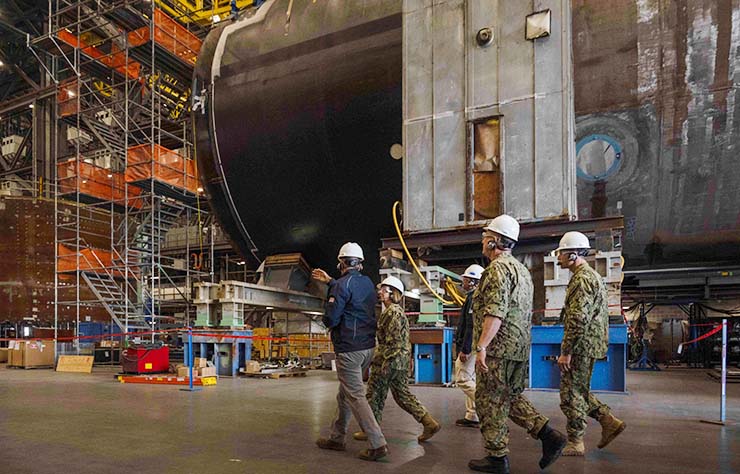
Danville (Virginia): The building with a glass facade in a largely empty industrial park here in rural Southside Virginia maybe a far cry from a traditional factory churning out submarine components.
However, US Navy officials say this building, the Additive Manufacturing Centre of Excellence, represents the future of the submarine industry — and perhaps the service’s only path to building the Columbia-class ballistic missile submarine and Virginia-class attack submarine on time. By next year, as the workload for the US submarine-industrial base ramps up to its highest level in 40 years, the Navy will 3D-print metal parts as standard components for installation on new-construction submarines.
The Additive Manufacturing Centre of Excellence is seeking to expand the supply chain for submarine parts by helping companies take up metal additive manufacturing. There’s pressure on the Navy to make this technology work. Already the service spent $2.3 billion to expand and strengthen the submarine-industrial base, and it’s poised to spend billions more, with additive manufacturing being one of five focus areas of this spending.
“It is a manufacturing capacity imperative” if the Navy and its industrial base stand any chance of ramping up to building one Columbia- and two Virginia-class submarines every single year for the next decade, said Matt Sermon, the executive director at the Navy’s Program Executive Office Strategic Submarines.
“Progress is being made, but it’s still not a push-button technology where we can say: ‘Make this part with this material and you’ll get out what you need,’ ” said Kevin Jurrens, who leads the National Institute of Standards and Technology’s work on smart manufacturing.
The Navy is trying to achieve a submarine construction rate not seen since the 1980s: It is simultaneously replacing its ballistic missile submarine fleet and growing an attack submarine fleet that today is only 75% of the Navy’s required size. However, the industrial base of companies contributing to these submarines has shrunk more than 70% since the 1980s, from about 17,000 suppliers to 5,000. And the ramp-up in workload is happening relatively fast.
As recently as 2013, the Navy began building one Virginia sub each year. Starting in fiscal 2026, the Navy plans to perform five times that work — two Virginias and the much-larger Columbia every year — given the complexity of submarines. Even the jump to two Virginia subs a year caused the construction line to miss milestones, and today some boats are a year or more behind schedule due to the COVID-19 pandemic. Related logistics and workforce challenges worsened the delays. The Navy now expects to return to on-time delivery by fiscal 2028.
But the service says the high-priority Columbia submarine cannot fall behind schedule.
Rear Adm. Scott Pappano, the program executive officer for strategic submarines who also oversees the overall submarine-industrial base program, said the Navy faces an uphill battle. Though the entire workload will quintuple, that actually creates a tenfold increase for some sectors like castings, which is already a weak spot in the supply chain.
Castings, or pouring hot metal into molds, is among the most challenged areas — and one that can be supplemented with metal additive manufacturing. “We know where our constrained market sectors are,” Pappano said.
Whitney Jones, the director of the Navy’s submarine-industrial base program, said internal models show certain metal components will see up to a 6.4-times increase in demand when industry reaches its peak submarine construction rate.
The industrial base is already behind building these metal parts: Today, there are more than 100 so-called sequence-critical material parts — meaning they will hold up construction if they’re unavailable — that are delivered more than 300 days late on average but are eligible to be 3D-printed. Printing these parts instead of casting them would mean each piece would take less time to make and would allow more companies to simultaneously produce them, reducing or eliminating delays at both the supplier and shipyard levels.
Jones said metal additive manufacturing could increase capacity for these metal parts by 15% to 20% in two to three years, while also improving the quality and cutting production time by as much as 90%. As with plastic 3D printing, there are several methods for printing metal parts. The most common and mature one uses a laser beam to melt metal powder, which, layer by layer, creates the desired shape based on a digital model.
Pappano said 3D printing is the right approach. “I take hot metal and I pour it into sand,” he said of traditional castings. “It’s very medieval.” But with additive manufacturing, he explained, “I can control weld pool temperatures and deposition rates. … I can monitor that deposition, I can look for inconsistencies during the build of the thing, and then ultimately I can go do non-destructive testing on it or destructive testing to go prove” its quality.
The Navy in May installed a new ventilation diffuser on the Ohio-class ballistic missile submarine Kentucky. This otherwise unremarkable part — a metal vent cover that directs airflow — marked the first printed metal part to be installed on a submarine.
More recently, the Navy turned to 3D printing for a sanitation system valve on another ballistic missile submarine in depot maintenance in Bangor, Washington. The original manufacturer went out of business, and it would have taken two years to get a similar part through the traditional supply system.
The Navy instead took an existing valve, laser-scanned it, reverse engineered the part in a computer-aided design system, printed prototypes using different methods, tested them, and then delivered the final part back to Washington for final machining and installation. Instead of a March 2025 delivery date, the part was ready for an October 2023 installation. But officials say the Navy must move beyond these one-off efforts and scale up its work to design, qualify and install printed parts on submarines.















